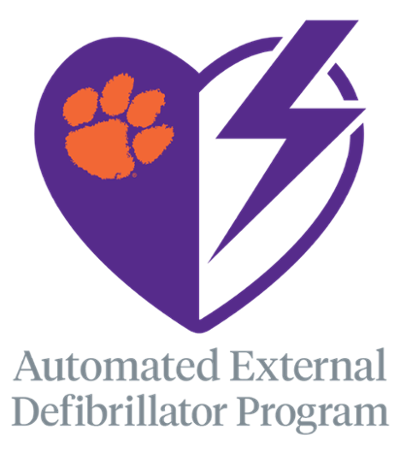Clemson University AED Program
Clemson University, in pursuit of providing a safe and healthy campus to all faculty, staff, students, and visitors has established an AED Program to coordinate and facilitate the distribution of AED devices on Clemson University campuses.
Contact Us - aedprogram@clemson.edu

Clemson University AED Program Guidelines
The use of AED’s will be in compliance with the responsibilities and procedures outlined in this program and consistent with guidelines outlined by the State of South Carolina. Click here for the SC State Law for AED's.
AEDs and Sudden Cardiac Arrest
Sudden cardiac arrest occurs when the heart stops beating. This condition affects nearly 400,000 Americans annually, and is responsible for 1 death every 37 seconds in the United States. Each year, sudden cardiac arrest claims more lives than cancer, diabetes, respiratory diseases, and accidental trauma combined. AEDs are a vital link in the chain of survival, and have been clinically proven to increase survival from sudden cardiac arrest. Studies have shown that the early application (within 3-4 minutes of the onset of cardiac arrest) of an AED can increase survival rates by nearly three times.
An automated external defibrillator (AED) is a small, portable device that analyzes the heart’s rhythm for any abnormalities and, if necessary, directs the rescuer to deliver an electrical shock to the heart of someone suffering from sudden cardiac arrest. This shock, called defibrillation, may help the heart to reestablish an effective rhythm. Click here to watch a video.
Out-of-hospital Chain of Survival
- Recognition of cardiac arrest and activation of the emergency response system
- Early cardiopulmonary resuscitation (CPR) with an emphasis on chest compressions
- Rapid defibrillation
- Advanced resuscitation by Emergency Medical Services and other healthcare providers
- Post-cardiac arrest care
- Recovery (including additional treatment, observation, rehabilitation, and psychological support)
AED Program Participation FAQs
-
What are the benefits of participating in the AED Program?
The Clemson University AED Program provides for standardization of AED units on campus, including purchasing, maintenance, testing, training and record keeping in order ensure consistency of use and a centralized database for record keeping.
-
Who is responsible for the Clemson University AED Program?
The Clemson University Safety Council in coordination with Clemson University Fire & EMS is responsible for campus AED program oversight. The Clemson University Fire & EMS Chief, or his/her designee will serve as the AED Program Manager and be responsible for ensuring that the AED Registry stays up to date, as well as provide guidance to various campus departments with implementation and maintenance of the AED(s).
-
What are the responsibilities of the AED Site Coordinator?
The AED Site Coordinator is responsible for implementing the AED program within their department or unit and serves as the primary contact for the AED(s) in their work area.
-
Who pays for the AED?
If University funds are unavailable, requesting departments are financially responsible for the AED equipment purchase, alarmed storage box, signage, medical oversight, installation, and any maintenance according to the manufacturer’s guidelines. Refer to the complete AED Program Guidelines.
-
How does a department purchase an AED?
The preferred AED packages will be listed in the BuyWays Procurement program for the purchasing departments to access and order.
-
Do I need approval to purchase an AED?
Yes, in accordance with the SC AED Act and the Clemson University AED Program, the AED Site Coordinator must apply and obtain approval from the AED Program Manager prior to finalizing the purchase in BuyWays.
-
What do I need to do if I am no longer able to serve as an AED Coordinator for my building?
The Building Security Coordinator should be notified as soon as possible to allow him/her to identify another person in your department to replace you. The AED Program Manager should be notified as soon as a replacement is identified. If a Site Coordinator cannot be identified to maintain the AED, the AED will be subject to removal from the site by the AED Program Manager.
-
If AEDs are so easy to use, why do people need formal training in how to use them?
An AED operator must know how to recognize the signs of a sudden cardiac arrest, when to activate the EMS system, and how to do CPR. It's also important for operators to receive formal training on the AED model they will use so that they become familiar with the device and are able to successfully operate it in an emergency. Training also teaches the operator how to avoid potentially hazardous situations. Access the American Heart Association CPR & ECC AED training resources.


